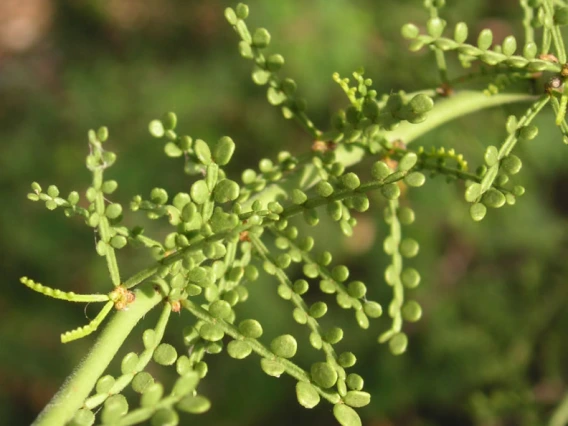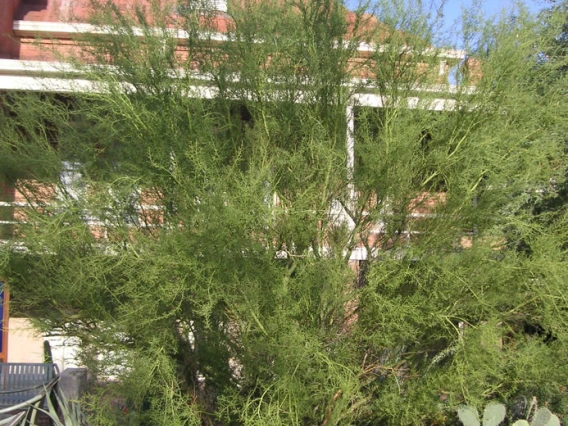


Common Names:
- English: Foothills Palo Verde
- Spanish: Palo Verde
- O’Odham: Kuk Chehedagi
Family Name: Fabaceae (pea/legume family) | Synonym:Leguminosae
Botanical Name: Parkinsonia microphylla
Rain Garden Zone: P. microphylla thrives in the terrace Rain Garden Zone, but can grow well in the top Rain Garden Zone as well. The terrace zone is typically atop a terrace or on the bank of a basin or swale. These sites have more shallow, less-frequent, and more temporary pooling than in bottom zone. The top zone, is the area beside, but not in the basin where plant root crowns stay dry, but where roots can access water harvested below in the basin. This location is the driest and warmest of the three zones.

Reproduced with permission from "Rainwater Harvesting for Drylands and Beyond" by Brad Lancaster, HarvestingRainwater.com
Flowering Season: Late March—Mid May
Harvest Seasons:
- Green Seed: Late April, May
- Dry Ripe Seed: June through early July
Harvesting Techniques: Branches of P. microphylla break easily, so be cautious when bending branches to reach pods. Pick palo verde pods by hand and store in baskets or buckets.
Planting Season: Monsoon
Planting Techniques: Nick the side of the seed coat just enough to crack the outer shell. This allows water imbibition needed for germination.
Characteristics: P. microphylla is a tree that is notable for its bright yellow-green bark. In fact, palo verde means “green pole” in Spanish. This bark allows the tree to carry out photosynthesis even after the leaves have fallen in the hot summer months. Unlike the blue palo verde tree (P. florida), the foothills palo verde does not have spines on the branches; rather, the branches terminate in a narrow point. The flower is a creamy yellow with a white banner petal. The fruit of the foothills palo verde are stiff, tan legumes ranging from 4-10 centimeters long with 1-4 seeds.
Ecological Benefits: Palo verde trees are the primary nurse plants for the saguaro, providing a favorable microclimate for the saguaro to develop when young. The foothill palo verde provides shade for vulnerable saguaro seedlings and the leaf litter provides a nitrogen rich root zone environment. Further, the symbiotic partnership with root mycorrhizal fungi, allows the palo verde to deliver nutrients to the seedling. The fragrant, bright yellow blooms of the foothills palo verde attract various bees and other pollinators, while the canopy provides shade and shelter for mammals and birds.
Practical Uses:
- Food - Both the flowers and the bean pods of the foothills palo verde are edible. Green seeds can be blanched in pods and eaten immediately, frozen for later, or dried and ground into a flour. Mature, dry seeds can be ground into a flour as well as soaked and sprouted for use in recipes.
- Domestic Animals - Palo verde beans can be dried and used for cattle feed. Honey bees drink nectar, pollinate, and produce honey.
- Other Uses - Foothills palo verde has traditionally been used as a key source of food, and it is useful for shelter and wood/timber as well.
References:
- Desert Harvesters. (2018). Eat mesquite and more: a cookbook for Sonoran desert foods and living. Tucson, AZ. RainSource Press.
- Hodgson, W. C. (2001). Food plants of the Sonoran desert. Tucson, AZ. University of Arizona Press.
- Jay Withgott, Botanical Nursing: From deserts to shorelines, nurse effects are receiving renewed attention, BioScience, Volume 50, Issue 6, June 2000, Pages 479–484, https://doi.org/10.1641/0006-3568(2000)050[0479:BN]2.0.CO;2
- Lancaster, B. (2019) Rainwater harvesting for drylands and beyond, 3rd edition. Tucson, AZ. RainSource Press.
- Little, E. L. (1980). The Audubon Society field guide to North American trees, western region. Alfred A. Knopf.
- Spellenberg, R. Earle, C. Nelson, G. (2014). Trees of Western North America. Princeton, New Jersey. Princeton University Press.
For more information on this plant, see the Campus Arboretum species description pages.
Go to the next tour stop: prickly pear page or Return to the main Dunbar Spring tour page

